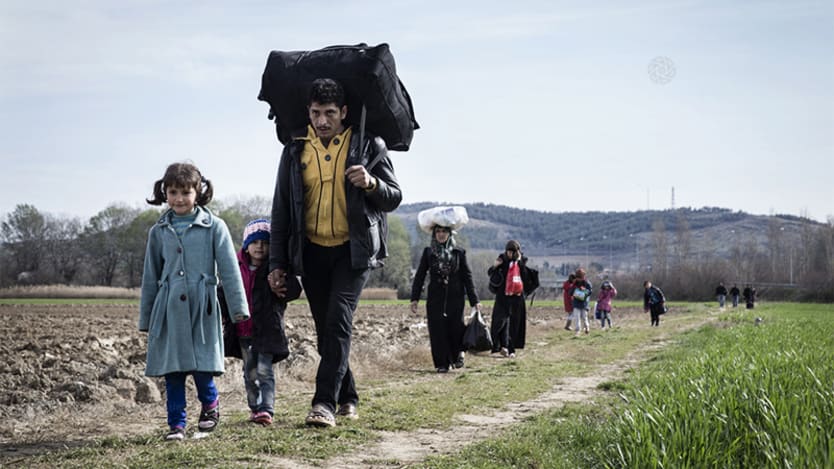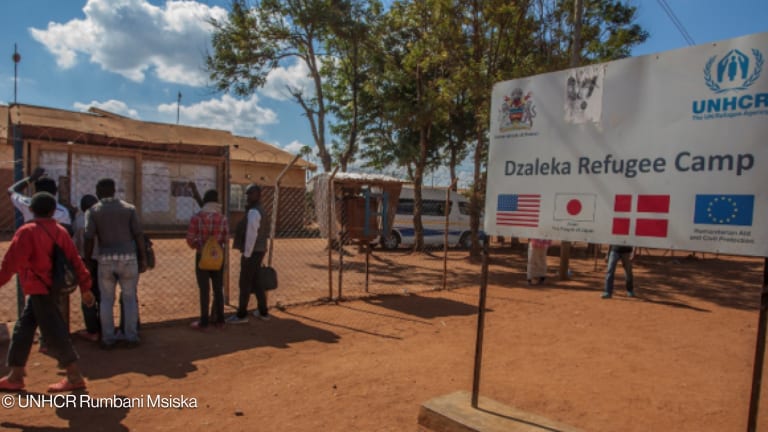
Last week, the European Union announced it would be unveiling an emergency aid plan that would make 700 million euros ($766 million) available to “provide help where it is most needed,” in response an estimated 10,000 refugees stranded on the Greece-Macedonian border — and in anticipation of hundreds of thousands of new arrivals in the coming months.
Faced with the world’s worst refugee crisis in recorded history, governmental and nongovernmental actors have their work cut out for them. With limited resources and an ever-growing number of asylum-seekers with numerous needs, humanitarian aid actors and government authorities face myriad challenges — from how to provide medical care and education to refugees on the move, to finding sustainable solutions to even more basic needs, such as food, sanitation and shelter.
These challenges are becoming more complicated as the conflict in Syria enters its sixth year, forcing humanitarian responders to find a balance between serving refugees immediate needs while simultaneously looking at longer-term solutions, in an environment where funding is limited and public opinion increasingly less sympathetic.
Devex interviewed a number of international and local actors on the front lines of the refugee crisis to gauge their greatest obstacles, and the innovative strategies they are employing to overcome them.
Adapting to the needs of mobile populations
A huge mobile population that is using unpredictable routes to travel across multiple international borders, the Syrian refugee crisis presents challenges that even experienced humanitarian actors may not have encountered before.
“One of the key challenges for us is understanding the nature of the hazard,” Simon Eccleshall, head of disaster and crisis management at the International Federation of Red Cross and Red Crescent Societies, told Devex. “Usually when you respond to a natural disaster there’s certain predictability. In this case, we don’t know when people are coming or even necessarily which routes they are going to take — and that makes it difficult to know how to effectively reduce vulnerability.”
In an effort to respond to some of these challenges, the IFRC has had to adapt quickly in the field.
“When it comes to people on the move, there are different strategies for different groups among them,” said Eccleshall. “If you look at the hierarchy of needs, first is information and helping them get access to information — having the places where they can charge their mobile phones and access to Internet so they can be in touch with their loved ones — is paramount.”
One of IFRC’s first moves was to forgo larger, stationary refugee camps along key refugee routes in lieu of small, flexible and agile mobile stations that can follow refugee’s shifting routes. Another strategy has been to change their refugee kits to suit the needs of a population that won’t be in one place for long.
“We aren’t giving them standard relief items — we’ve had to change it to what suits people on the move,” said Eccleshall. “The packs of snacks and water bottles that are fairly light and disposable, reflective blankets rather than heavy woollen blankets. And we try to provide assistance by linking them up to Red Crescent points across borders.”
Forming effective, coordinated, and responsive partnerships with other humanitarian actors in the field has also become necessary for everyone working with refugees as they attempt to cross Europe.
“Rather than providing people what we think they need, it’s better to provide people with financial assistance, so they can make decisions as to what they actually need.”
— Mark Smith, senior director of humanitarian emergencies at World Vision“One day there may only be a few boats that land, and the next day we might suddenly have thousands of people,” said Michele Telaro, project coordinator for Médecins Sans Frontières on the Greek island of Lesbos. “Everyone is really open to collaboration because everyone is needed, and the authorities can’t cope alone.”
On the island, humanitarian actors generally communicate with one another via various WhatsApp groups which allow them to share news with large groups of people within seconds.
Then there’s the issue of addressing medical concerns with a population that may only be in one place for a matter of days.
“From a medical point of view, it’s difficult to give medical assistance for just one day,” said Telaro. “But when people arrive here from Turkey, they just want to go and continue their travels, so we meet a patient and we know that we should follow up, but often that’s just not possible.”
Drawing on technological tools for creative solutions
In order to keep up with migrants needs, more and more humanitarian actors are also looking towards technology as a tool for short- and long-term aid strategies — from GPS mapping of refugee routes, to providing accessible online, multilingual information portals, to handing out cash cards and even developing online educational tools.
According to Mark Smith, senior director of humanitarian emergencies at World Vision, the relatively high level of education among Syrian refugees has enabled humanitarian organizations to provide more and more information and services online.
“In the case of Syrian refugees, we aren’t dealing with a population that was the poorest of the poor before the conflict began,” he said. “A lot of refugees have smartphones and are very Internet-savvy, so we’ve been able to develop Web-based technological platforms that contain the information people need as they are making it into Europe.”
One platform, Refugee Info — developed and updated by numerous humanitarian actors — contains information on buses and border crossings, where asylum-seekers can get necessary supplies.
“The key is that we are feeding all of that information into one spot, and all agencies have access and are able to give updates,” said Smith. “This sharing of information and putting it all in one place becomes very important in serving populations on the move.”
Another key resource is geographic information systems satellite images to map population movements, so they know how many people they might need to prepare for, and where they can go to best serve them.
According to Smith, World Vision has also been experimenting with using cash credit programs instead of giving refugees traditional aid packages.
“Rather than providing people what we think they need, it’s better to provide people with financial assistance, so they can make decisions as to what they actually need,” he said.
The international nongovernmental organization is even exploring how to develop online educational courses for refugee children, almost all of whom suffer from significant educational gaps due to displacement.
“I think there are really exciting possibilities with web-based solutions for education in environments like this that families can access with their children,” said Smith. “Cash programming is something that is becoming much more mainstream.”
Stopping refugees at source
Providing aid to internally displaced people within Syria and Iraq before they feel the need to flee their homeland is another space that is critical to preventing them from having to leave in the first place.
However, for humanitarian actors working with mobile populations in conflict zones, the growing violence in parts of Iraq and Syria have made it all but impossible to provide effective aid to increasingly vulnerable populations. This failure to meet the needs of vulnerable populations in conflict zones could easily lead to the creation of new refugees in the months to come. According to Smith, one of the major challenges facing humanitarian actors in Syria and Iraq as the conflicts increasingly become more widespread and violent is the “shrinking of the humanitarian space.”
“In Syria, as opposed to working with refugees in Lebanon or Jordan, the challenges we are facing there is just access,” he said. “People are on the move, but they are moving through dangerous areas and working with those populations is very hazardous. For example, a couple of our facilities have been hit by bombs so we had to suspend work, and one of our partners had one of their staff members killed, so it’s a difficult environment in which to provide assistance.”
In practice, this means that large international organizations become increasingly reliant on local partners based inside the conflict zones.
“We have a number of Syrian partners that are working in those areas — and that’s where they want to work,” said Smith. “Even so, this can present a moral dilemma, and we need to ask ourselves whether we are asking them to take risks we are not willing to take. It’s something we need to think about.”
Smith advises organizations working with local partners in conflict areas to develop intentional partner strategies before beginning the partnership — and think about how to best work with the partner, provide them with any training they might need, and address any capacity issues they might have.
Managing funding challenges
As the world is flooded with images of large crowds of asylum-seekers landing in boats on the Greek islands, or stranded at border checkpoints, securing sustainable funding is becoming a challenge for all organizations.
“There’s a concern over what we call donor fatigue, and an impatience with the revolving door problem,” said Joel Millman, spokesman for the International Organization for Migration. “They want to see how to stop people from taking these dangerous voyages, and they aren’t necessarily happy with how the containment of this issue is going.”
The nature of humanitarian funding — how and when it is allotted — also creates challenges for organizations hoping to create programming that addresses the long-term needs of refugees.
“You talk to any aid organization and, from a funding perspective, they are probably looking at 90 percent of their funding coming from United Nations and government donors, and most humanitarian financing tends to be short-term — one year at most,” said World Vision’s Smith. “How do you do long-term planning if you don’t know whether you have a grant six months from now? It becomes impossible to create meaningful long-term strategies when your financing is all short-term in nature.”
Then there’s the sensationalistic press coverage that has become more and more negative in recent months.
“We have faced this already in 2016,” said Millman. “There’s been a wave of provocative stories about the wild attacks in Cologne, and there is something almost every day about a rape, or a knifing, or someone setting a refugee camp on fire — all of this erodes the will we could build to support the migrants and refugees.”
Unfortunately, securing sustainable financing is something that all organizations dealing with refugees need to continue their work — which is why it’s one of the key issues up for discussion at the World Humanitarian Summit in Istanbul, Turkey, in May.
“There is a danger that the public could grow cynical and lose faith that these are manageable problems, and that we have the ability to manage them,” said MIllman. Unfortunately, he said, this doubt often becomes a self-fulfilling prophecy.
“We made it clear as can be that we can’t run the risk of cutting food rations in half in refugee camps, because those refugees will have no choice but to leave and look elsewhere to survive,” he said. “But the public didn’t respond strongly enough, so it wasn’t pushed hard enough in donor countries. Maybe next year, when there are a million new refugees because we didn’t address these basic issues before, we’ll see more traction.”
What is the biggest challenge facing aid actors working with refugees on the move, and how can it be overcome? Have your say by leaving a comment below.
Across Borders is a monthlong online conversation hosted by Devex and partners — World Vision, the European Commission's Humanitarian Aid and Civil Protection department, the U.S. nonprofit partner of the International Organization for Migration and United Nations Volunteers — to analyze and amplify the discussion on global migration and current refugee crises through the lens of global security, development cooperation and humanitarian aid work, and more. Visit the campaign site and join the conversation on social media tagging @devex and #AcrossBorders.
Read more #AcrossBorders stories:
► #AcrossBorders: Changing the migration narrative
► #AcrossBorders and origins: Can we get smarter at preventing people from fleeing?








